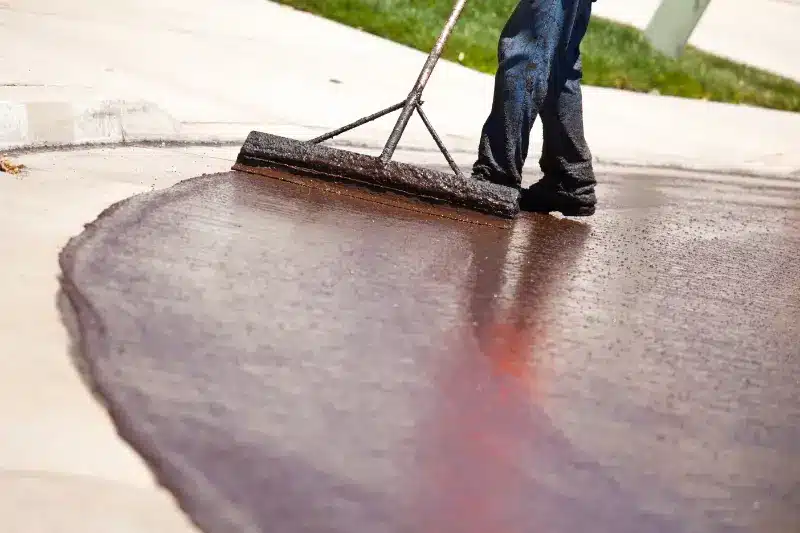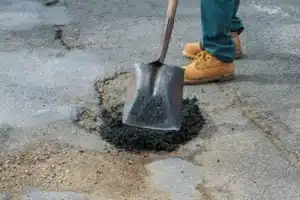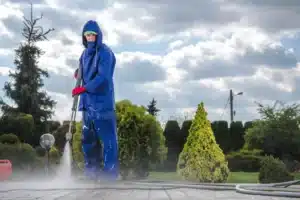Ever walked on a sparkling, sealed concrete driveway and suddenly found yourself skidding? Safety and concrete surfaces may not be the most obvious pairing, but sealing concrete is a critical consideration. One common question is, “Does sealing concrete make it slippery?” This blog post will guide you through understanding the slip factor, the interplay between texture and sealants, selecting the right sealer, combating slipperiness, maintenance tips, and handling wet weather conditions.
Key Takeaways
- Understanding slip factors of sealed concrete and the role of sealer type in surface slipperiness is essential for maximum traction.
- Incorporating a non-slip additive or applying an anti-slip coating can help to reduce slippage on sealed surfaces, while regular maintenance and cleaning techniques are necessary to sustain safety.
- In wet conditions, precautionary measures such as using slip-resistant footwear should be taken for additional safety when walking on sealed concrete surfaces.
Understanding the Slip Factor of Sealed Concrete
Slippery surfaces are commonly linked to wet, shiny floors. Concrete-sealed surfaces can be very slippery when they come into contact with water, creating a slippery surface. Therefore, it is important to exercise caution when walking on wet surfaces. This slipperiness is often a result of using low-quality sealers or applying them excessively. However, there are ways to mitigate this.
Creating a pattern with substantial texture on a concrete surface is one way to enhance the slip resistance of stamped concrete. Another approach is to sprinkle sand on the surface before curing, creating a rougher surface for the sealer and reducing slipperiness.
The Role of Sealer Type in Surface Slipperiness
The type of sealer you choose plays a crucial role in determining the slipperiness of your concrete driveway. Some sealers can increase slipperiness, while others can preserve or even enhance traction. You might be tempted to apply a thick coat of sealer to your concrete to make it shiny and appealing. But beware, this can make your stamped concrete slippery. Instead, consider using a penetrating sealer. These sealers are absorbed by the concrete and form a protective barrier without creating a slick surface.
When choosing a sealer, consider the availability of slip-resistant additives. These materials can be incorporated into an acrylic sealer to provide a slip-resistant coating. For clear decorative concrete sealers, micronized polypropylene is typically used. This additive provides a smoother feel to the coating surface with a uniform particle size, which reduces slipperiness, particularly when wet.
Application Techniques that Influence Traction
The application method of the sealer also influences the level of slipperiness on the concrete surface. Incorrect application of sealer can make a stamped surface slippery. This is a common example of how the wrong material or process can impact a project.
Applying the correct amount of sealer is key to preventing increased surface slipperiness. The most effective tools for applying a concrete sealer to increase traction are:
- Roller
- Sprayer
- Broom
- Squeegee
SunStamp from ATD Concrete Coatings is a product that can be used to create textured patio areas. It is designed to help you create beautiful outdoor living spaces. Companies like SUNDEK can also assist by resealing stamped concrete using additives and implementing texture and appropriate sealing practices.
The Interplay Between Texture and Sealants
The texture of sealed concrete significantly affects its slipperiness. Here are some key points to consider:
- Topical sealers can make it slippery when wet by covering the natural texture.
- Penetrating sealers don’t change the concrete’s look or texture.
- The concrete’s texture can impact the effectiveness of the sealer, with some sealers performing less well on rough or textured surfaces.
Penetrating sealers are typically the most suitable option for highly textured concrete surfaces. They can protect the surface against water, stains, and damage caused by UV rays. However, the surface texture can significantly influence the slipperiness of sealed concrete. For instance, applying a wet-look sealer can fill in ridges and surface texture, potentially increasing the slipperiness of the concrete. Therefore, it’s crucial to consider the texture of the concrete when sealing it to ensure adequate slip resistance.
Selecting the Right Sealer for Your Concrete Driveway
Selecting the proper sealer for your concrete driveway goes beyond aesthetics, encompassing safety, durability, and maintenance factors. Wet-look concrete sealer is an acrylic-based topical sealer that provides a glossy finish. However, it can be challenging to coordinate with concrete caulk and exposure to UV rays can lead to breakdown and discoloration.
In terms of improving the slip factor of a concrete driveway, a penetrating sealer is often your best bet. It is absorbed into the concrete’s pores, forming a protective barrier against moisture, deicing agents, and other potentially slippery substances.
Penetrating vs. Topical Sealers
If you’re not a fan of the glossy finish of wet-look concrete sealers, penetrating sealers are an excellent alternative. These sealers offer the following benefits:
- They penetrate the concrete to form a chemical barrier.
- They maintain the concrete’s natural appearance.
- They offer superior resistance to abrasion, heat, and UV rays.
When deciding between a penetrating and a topical sealer for your concrete driveway, consider factors like slipperiness, surface appearance, application requirements, and protection needs.
One of the key advantages of penetrating sealers is that they maintain the natural aesthetics of concrete. They become invisible upon drying and do not alter the surface texture or appearance of the concrete, allowing you to showcase its natural beauty.
Combating Slipperiness: Additives and Coatings
Despite your precautions, a sealed concrete surface might still become slippery. Do not worry – additives and coatings can provide a solution! Grit additives or anti-slip coatings can be used to increase grip without compromising the benefits of the sealer. For instance, sealers with anti-slip additives or coatings can help reduce slipperiness.
Anti-slip coatings offer additional security against slipping, providing both safety and aesthetic advantages. Regular resealing and proper cleaning techniques can also ensure the longevity of your sealed concrete and prevent slippage.
Shark Grip and Other Grit Additives
Shark Grip, a grit additive, enhances slip resistance on sealed concrete surfaces by creating a rough texture that increases traction and reduces the risk of slipping. Incorporating grit additives has become a popular technique for mitigating slipperiness on exterior walking surfaces.
In areas with heavy traffic, steep slopes, and commercial settings often require slip-resistant additives. Hard mineral materials like aluminum oxide and silica sand are good choices. When using these additives, finding the right balance between size and distribution is important. Smaller particle sizes placed closer together deliver notable traction but can make the surface challenging to clean.
Particles with larger sizes when placed far apart allow for a good grip on the ground. It is also much easier to clean these areas.
The Benefits of Anti-Slip Coatings
Anti-slip coatings offer improved grip without compromising the benefits of the sealer, including protection from weathering and staining. There are several types of anti-slip coatings available for sealed concrete, including:
- Epoxy-based coatings
- Polyurethane coatings
- Acrylic coatings
- Rubberized coatings
- Textured coatings
These coatings add an extra layer of protection, creating friction that makes the surface less slippery and improves traction for pedestrians. This is particularly important in commercial buildings or areas with high foot traffic.
The average lifespan of anti-slip coatings on sealed concrete surfaces can vary, with industrial epoxy applications typically lasting between 5 to 10 years.
Maintenance Tips: Keeping Your Sealed Concrete Safe

Maintaining the safety of your sealed concrete is an ongoing process that involves regular upkeep. For extended durability of your sealed concrete, periodic resealing is necessary for sustained slip resistance, and correct cleaning methods are needed to deter slippage. Sealing concrete is essential for ensuring the longevity and safety of your surface.
Resealing enhances traction on sealed concrete surfaces through the use of grit additives. These additives help to reduce slipperiness and sustain the traction of the concrete, reducing the likelihood of slippage when wet. It’s also important to use concrete-friendly snowmelt chemicals in combination with sand to eliminate snow or ice that can create a hazardous surface.
Resealing for Continued Slip Resistance
Water-based silane/siloxane blends and acrylic epoxies are recommended for resisting slip when resealing the concrete. It is generally advised to reseal concrete every two to five years for enhanced slip resistance.
The process for resealing concrete with slip-resistant additives involves:
- Mixing the gritty additive into the sealer
- Applying the sealer with the slip-resistant additive to the concrete surface
- This can be done by using sealers that come with the grit premixed or by adding the additive to the sealer
- Applying the sealer to the concrete using a roller or brush
Applying multiple thin coats for optimal durability and slip resistance is recommended.
Cleaning Techniques to Prevent Slippage
To ensure slip resistance on sealed concrete surfaces, the following tools and materials are recommended:
- A good quality dry vac with a horsehair brush attachment on the wand for routine vacuuming
- White vinegar or phosphoric acid cleaner for more thorough cleaning
- A tampico brush or scouring pad for scrubbing
- Soft cloths for wiping
- Soap or detergent for cleaning
- A bucket of water for rinsing
- A scraper for removing stubborn stains
By fixing slippery concrete, you can ensure that your sealed concrete surfaces remain slip-resistant with the help of appropriate tools and materials.
The intense pressure from a pressure washer can potentially damage the surface of the concrete, making it smoother and potentially more slippery. It is thus important to exercise caution when using the pressure washer and to avoid excessive pressure to maintain the slip resistance of the sealed concrete surface.
When cleaning sealed concrete surfaces, it is recommended to use pH-neutral cleaners to protect the sealed surface and maintain its shine. Soap-based cleaners should be avoided due to their high alkalinity, which can damage the finish of the concrete.
Sealed concrete surfaces should be cleaned regularly, preferably every one to two weeks for optimal slip resistance. In addition, a monthly high-pressure cleaning may be beneficial to remove any persistent contaminants.
Navigating the Weather: Sealed Concrete in Wet Conditions
Weather conditions can significantly influence the slipperiness of sealed concrete. Some factors to consider include:
- Rainfall, which can lead to a layer of moisture on the surface, enhancing its slipperiness
- Extreme temperatures, such as freezing or high heat, can also cause the sealed concrete to become more slippery
- High humidity levels, which can contribute to the slipperiness of sealed concrete
To prevent accidents, it’s important to be aware of these weather conditions when walking on sealed concrete surfaces.
To minimize slipperiness on sealed concrete during wet weather, here are some recommendations:
- Incorporate a non-slip additive
- Apply an anti-slip coating
- Regularly clean and maintain the surface
- Use slip-resistant footwear
- Install drainage systems.
Summary
In conclusion, understanding the slip factor of sealed concrete and implementing safety measures can safeguard against potential accidents. By considering the interplay between texture and sealants, choosing the right sealer, combating slipperiness with additives and coatings, and maintaining your sealed concrete, you can ensure a safe and attractive concrete surface. Remember, the safety and durability of your sealed concrete are not only a result of its initial installation – ongoing maintenance and proper cleaning techniques play a vital role too.
Frequently Asked Questions
How do you seal concrete without it being slippery?
To ensure slip-resistant stamped concrete, apply a thin coat of sealer to provide water resistance without making it overly slippery.
Does concrete sealer make the floor slippery?
Using low-quality concrete sealers can make the floor slippery as a solid layer on its surface becomes slippery when wet.
What can I add to the concrete sealer to prevent slipping?
To reduce slipperiness when sealing concrete, mix grit additives into the sealer and apply the mixture to the surface.
How can the slipperiness of sealed concrete be reduced?
The slipperiness of sealed concrete can be reduced by creating a pattern with substantial texture, selecting the appropriate sealer, and applying it correctly.







